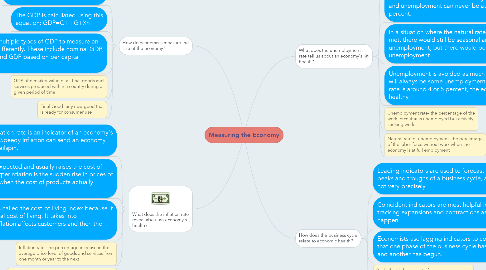Measuring the Economy
by Reid Segal

1. How do economists measure the size of the economy?
1.1. A nation's economy will usually be measured using the gross domestic product or GDP.
1.2. The GDP is calculated using this equation: GDP=C+I+G+Xn
1.3. There are multiple types of GDP to measure an economy differently. These include nominal GDP, real GDP, and GDP based on per capita amounts.
1.4. GDP- the market value of all final goods and services produced within a country during a given period of time
1.5. Final Good- any new good that is ready for consumer use
2. What does the unemployment rate tell us about an economy's health?
2.1. There are three types of unemployment: cyclical, seasonal, and frictional.
2.2. There is a natural rate of unemployment, and unemployment can never be at 0 percent.
2.3. In a situation where the natural rate of unemployment is met, there would still be seasonal and frictional unemployment, but there would be no cyclical unemployment.
2.4. Unemployment is avoided as much as possible, but there will always be some unemployment. If the unemployment rate is around 4 or 5 percent, the economy is fairly healthy.
2.5. Unemployment rate- the percentage of the work force that is unemployed but actively seeking work.
2.6. Natural rate of unemployment- the percentage of the labor force without work when the economy is at full employment
3. What does the inflation rate reveal about an economy's health?
3.1. The inflation rate is an indicator of an economy's health. Speedy inflation can send an economy into a tailspin.
3.2. Creeping inflation is expected and usually raises the cost of products gradually, hyperinflation is the sudden rise in prices of products, deflation is when the cost of products actually decreases.
3.3. The CPI is sometimes called the cost-of-living index because it approximates the total cost of living. It takes into consideration how inflation affects customers and then the economy.
3.4. Inflation rate- the percentage increase in the average price level of goods and services from one month or year to the next
3.5. Consumer price index- a measure of price changes in consumer goods and services over time; the CPI shows changes in the cost of living from year to year
4. How does the business cycle relate to economic health?
4.1. Leading indicators are used to forecast the peaks and troughs of a business cycle, although not very precisely.
4.2. Coincident indicators are most helpful in tracking expansions and contractions as they happen.
4.3. Economists use lagging indicators to confirm that one phase of the business cycle has ended and another has begun.
4.4. Peak- the highest point of an expansion, or period of economic growth; a peak is followed by economic decline
4.5. Trough- the lowest point of a contraction, or period of economic decline; a trough is followed by economic growth


